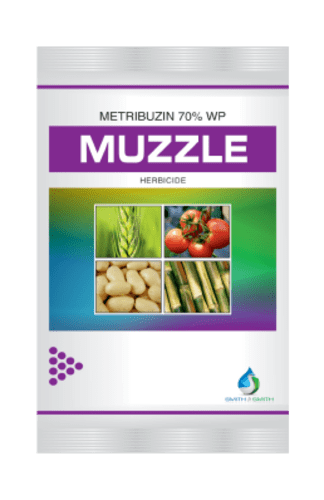
MUZZLE
MUZZLE
METRIBUZIN 70% WP
Weedicides
Weeds are a great threat to yield and crops. One of the factors that makes them a big threat is that they can grow anytime during the crop cycle.
Sugarcane, Potato, Tomato, Soyabean and Wheat can be impacted by various weeds namely:
Weedicide resistance is a new phenomena being noticed in case of study weeds. One such example is Phalaris minor; a pernicious weed, which infests several crops during the winter season, particularly the wheat crops in rice–wheat sequence. It has developed resistance to all major known chemicals.
Muzzle is a selective broad spectrum, pre as well as early post-emergence weedicide which belongs to Triazinone group. It acts on both grasses & broad leaf weeds through roots as well as foliar hence, providing dual effect/ protection. It a low dosage herbicide used for control of weeds in sugarcane, potato, tomato, soyabean and wheat. Dragon is highly recommended for use against Phalaris minor which has developed resistance to all major known chemicals.
Pack sizes: 100gm, 500gm.
Mode of Action
Muzzle belongs to group C1 of HRAC. It inhibits photosynthesis by binding to the QB-binding niche on the D1 protein of the photosystem II complex in chloroplast thylakoid membranes. Herbicide binding at this protein location blocks electron transport from QA to QB and stops CO2 fixation and production of ATP and NADPH2 which are all needed for plant growth. How- ever, plant death occurs by other processes in most cases. Inability to reoxidize QA promotes the formation of triplet state chlorophyll which interacts with round state oxygen to form sin- glet oxygen. Both triplet chlorophyll and singlet oxygen can abstract hydrogen from unsatu- rated lipids, producing a lipid radical and initiating a chain reaction of lipid peroxidation. Lipids and proteins are attacked and oxidized, resulting in loss of chlorophyll and carot- enoids and in leaky membranes which allow cells and cell organelles to dry and disintegrate rapidly. While using as pre-emergence, it is most essential to check that the soil is clothless and has sufficient moisture (5.10%) as in the case the product acts through roots.
Recommendation:
Wheat:
Dosage: 100 gm per acre
Time of Application: Post-emergence: 35days after sowing of crops Sugarcane:
Dosage: 400 gm per acre
Time of Application: Pre-emergence: 3-5days after planting | Post-emergence: 25-30days after planting
Soyabean:
Dosage: 300 gm per acre
Time of Application: Pre-emergence: 1-2days after sowing
Method of Application
- Plant protection equipment: Use Knapsack sprayer or Foot sprayer fitted with flat fan or flood jet nozzle is recommended.
- To ensure better effectiveness follow under mentioned:
- Pre Emergence – Ensure that field do not have clods and after spray do not disturb the soil - Pre and Post Emergence – Avoid drift of spray into adjoining crops without overlapping spray swaths and to keep uniform width, it is advisable to keep nozzle height constant from ground level i.e. 48-50cms.
Safety recommendations
- Do not use in sandy soil.
- Use spray on clear day.
- Do not dispose off surplus solution in crop lands or in stagnant or flowing water where there is possibility of polluting water sources.
- Avoid inhalation the spray mist and spray in the direction of wind.
- Keep away from food stuff, empty food stuff containers and animal food.
- Avoid contact with mouth, eyes and skin.
- Wash thoroughly the contaminated cloths and parts of body after spraying. - Do not smoke, drink, eat or chew while mixing and spraying.
- And wear full protective clothing while mixing and spraying.
- Antidote – No specific antidote is known. Treat symptomatically.
- Always refer to the SDS for detailed information on safety.
